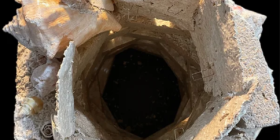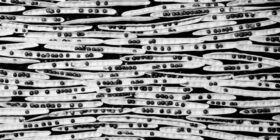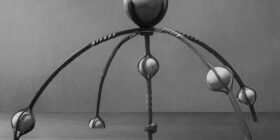Aesthetics get Synthetic: Knowledge Link through Art and Science – Tom Robinson
Aesthetics get Synthetic: Knowledge Link through Art and Science (KLAS) is an Artist in Residence program of the Max Planck Society. The innovative artist residency program brought professional artists into high-quality research groups and, by doing so, established a bridge between art, science and society. Knowledge Link through Art & Science (KLAS) fosters ArtSci exchanges and trans/disciplinary innovation and education whilst also creating a link between Synthetic Biology research groups in leading institutions.
Dr. Tom Robinson obtained his first degree in Physics at Imperial College London. After wanting to broaden his scientific interests but still utilised his background in Physics, he completed an interdisciplinary PhD between Chemistry, Physics and Biology. His last postdoc position was at the Max Planck Institute for Colloids and Interfaces in Potsdam, and since early 2016 has been an independent research group leader funded via the MaxSynBio network.
Interview conducted by Rodrigo Perez-Garcia, a chemist interested in tangential points of the arts and science, especially within Nanotechnology & Renewable Energy, Interfacial phenomena, Music, Art and Literature (Currently working at the Max Planck Institute for Colloids and Interfaces (Germany)). As co-founder of Polyhedra (www.polyhedra.eu), with Caterina Benincasa, Rodrigo coordinates and implements multi-disciplinary events like KLAS, catalysing connections between local realities and global cultures.
During the KLAS Artist in Residence program Tom Robinson collaborated with Otavio Schipper and Sergio Krakowski.
………………..
Question: Can you name your three favorite works of art of all times? Do you have any favorite artists?
Tom Robinson: This may be cheating but my first choice is always Monet’s entire Lily Pond series. If you ever get a chance to go to the MOMA in New York on a less crowded day you can get lost in those paintings. My second is The Promenade by Chagall. He’s holding his wife’s hand while she floats above him and it perfectly illustrates romantic love. My final one I saw recently at the Pompidou in Paris. It’s by Matta called Les Puissances du desordre. I can’t really say why I like it so much. It’s just crazy.
Also, spoken word. There are a few London-based poets I like who work with DJs to produce tracks.
Question: In your opinion what is that that makes a work of art to be interesting or simply good?
Tom Robinson: That’s a difficult question! For me it depends on the art medium. If it’s a painting for example, and if it grabs my attention then I know it’s interesting and “good”. I often find art more engaging once the motivation of the artist or history of the piece is explained to me. This is often the case for movies with me. As well as old paintings. For example, I don’t understand sculpture. That’s why I don’t enjoy them so much.
Question: It’s very often said that scientific research has a lot to do with creative thinking or even with finding aesthetically appealing solutions. As a scientist, what do you think about this? Do you feel like an artist sometimes? If so, could you give us an example?
Tom Robinson: I’m not an artist, but I do feel a bit like a designer or an engineer. My lab creates artificial cell mimics, which require planning and design for complex assembles at the micrometre scale. This requires a lot of creativity and imagination at the first conceptual idea stage. I love it when I’ve designed something, made a sketch of it, and then a few months later my lab members come to me with nice microscopy images of these cell-like systems in the real world!
Question: Over the history technology has deeply transformed both artistic practices and scientific research. In fact nowadays it seems almost impossible to think of either one or the other independently form technological advancements. Specifically thinking in terms of technology, do you feel like you could learn anything from certain artists?
Tom Robinson: Yes. The creativity that artists have can definitely be used in aspects of our research. In terms of technology I would say that we could benefit from designers and their knowledge of CAD tools. They could in theory help design our microfluidics channels. Most of what we do is in 2-D, but we have yet to explore 3-D microfluidic channel networks. They could definitely help us there.
Question: KLAS’ final aim is to foster a fruitful collaboration between scientists and artists and to create a mutual knowledge exchange that will hopefully point to new procedures and methodologies. But… beyond this mainly practical outcome, do you think art can also serve science in a more discursive, critical or political way?
Tom Robinson: Maybe. This is a difficult question for me to answer at this point. I guess we will find out more after KLAS round one is over.
Question: What are you currently working on?
Tom Robinson: Mimicking subcellular organelles using lipid membrane vesicles is one of my current main topics. Eukaryotic cells have evolved to have compartmentalised inner organelles which separates them from the prokaryotic cells. Current research in my field is limited to mimicking single-compartment prokaryotic cells. Our aim is to develop platforms (based on microfluidic technology) that will be able to produce multi-compartment vesicles and therefore bring us a step closer to studying complex eukaryotic cells and how they came to be.
Question: Can you talk about your ideas/motives to join KLAS from its inception?
Tom Robinson: My motivation was to engage with the public to give then a better understanding of what synthetic biology is or can be. KLAS will achieve this through the open colloquium where the art pieces will be presented along with scientific talks. Also, I love art and the idea of chatting to artist about this subject excited me.
Question: What are your thoughts around artists joining a scientific team? How can we guarantee the quality of the interactions between artists and scientists? Which are the keys to a successful interaction?
Tom Robinson: I’m no expert in this kind of interaction, but the first visit with Octavio was great. I got him in the lab doing experiments and I think/hope he got the idea via this hands-on approach. For me, actually doing something yourself is the best way to learn and understand and this is why I insisted he work in the lab for a successful interaction.
Question: What are your expectations from the artist-residency?
Tom Robinson: As above. Public engagement would be great. Also, if the artists can help with our work, that would be useful. Moreover, I hope to make some pure scientific collaborations with other synthetic biology groups (i.e. Groningen) via the future colloquium.
Question: The two weeks residency of the artist just finished. Did this have any impact (…on your ideas, methodologies, preconceptions? Inspirations?)
Tom Robinson: I guess my preconception of what an artist changed. I wasn’t aware of sound based art and this opened up my eyes to new media art projects. But it’s not over, I hope to meet Octavio again and also to meet his colleague. Moreover, the second visiting artist is yet to come!
Question: What is the best lesson you have learned in KLAS?
Tom Robinson: Through talking to the artist and I learnt how to better explain my work to people outside of my field. This may sound like a trivial thing, but communicating your aims and ideas to people outside of your field is sometimes difficult. This is an essential part of being a good scientist. A good scientist does good science but also enables others to understand their findings. Moreover, being able to explain your research in an interesting and engaging way is important for public engagement, future collaborations, and funding.
Question: Our call was addressed to all artists but we specified that in first place we would take into consideration those projects that involved contemporary procedures (new media, sonic art, new materials) and contemporary theoretical frameworks (New Materialisms, Object Oriented Ontology, Dark Ecology…). Can you highlight any shared areas of knowledge or parallelisms between the praxis of contemporary scientist, artists and thinkers?
Tom Robinson: Well I think there is a strong link between all three. Science tries to answer the big questions with facts and evidence. While, art and philosophy often look at world and ask the big questions. In the beginning, philosophers were what we would now call scientists. We just have more tools available to us. Who knows what artist will be able to achieve in the future as technology and tools become more and more accessible to everyone.
Question: What do you hope visitors take away from this project once it is presented?
Tom Robinson: A better understanding of synthetic biology and what it can achieve. Also, to enjoy the art and the discussions!
Question: How do you see KLAS developing in the future?
Tom Robinson: Expanding. Joining with other art-science programmes internationally. Maybe becoming a more permeant feature within the MPG.
Question: One (if any) surprise while working on this project?
Tom Robinson: One interesting outcome came via our conversations leading up to the artist’s visit. Arren Bar-Even and I realised that our work was very complementary to each other. His research approach to Synthetic Biology is to start with real cells and modify certain metabolic functions in a so called ‘top-down’ manner. Mine, on the other hand, is a ‘bottom-up’ methodology where I hope to learn about cellular functions by building up a minimal cell system that can mimic specific aspects of real cells.
I was impressed by Otavio’s knowledge of science and how up to date he was on current scientific treads and discoveries. This made for some surprising and fun discussions.
There may be more surprises yet to come, the project is far from over…
.…………….
Dr. Tom Robinson obtained his first degree in Physics at Imperial College London. After wanting to broaden his scientific interests but still utilised his background in Physics, he completed an interdisciplinary PhD between Chemistry, Physics and Biology also at Imperial College. Here he specialised in Microfluidic Technology and Advanced Microscopy with the application of improving the detection of enzyme-DNA binding. After which he spent 3 years as a Postdoc at ETH Zurich continuing his passion for microfluidics, but also being introduced to biomimetic lipid membrane vesicles. His last postdoc position was at the Max Planck Institute for Colloids and Interfaces in Potsdam working on synthetic lipid membrane fusion systems, and since early 2016 has been an independent research group leader funded via the MaxSynBio network. Now his group continues to develop novel microfluidic platforms and work on bottom-up synthetic biology applications.
Rodrigo Perez-Garcia is a chemist interested in tangential points of the arts and science, especially within Nanotechnology & Renewable Energy, Interfacial phenomena, Music, Art and Literature. Currently working at the Max Planck Institute for Colloids and Interfaces (Germany), he holds a Erasmus Mundus Masters in Theoretical Chemistry and Computational Modelling (The Netherlands -and Italy) and has conducted research residencies in Bristol (UK), Ispra (Italy) and Kyoto (Japan). As co-founder of Polyhedra (www.polyhedra.eu) Rodrigo coordinates and implements multi-disciplinary events like KLAS, catalysing connections between local realities and global cultures.
Caterina Benincasa obtained her degree in Physics and Philosophy (UK) and specialized in Aesthetics & Theory of Contemporary Art (MD), History of Science (MD) and World Heritage Studies (MD). She has been visiting lecturer at the Academy of Fine Arts in Sassari (Italy), researcher in Contemporary Visual Art (France), researcher in Neuroaesthetics at Don Gnocchi Foundation (Italy), and recently worked for the ‘Modern Geometry and the Concept of Space’ research group at the Max Planck Institute for the History of Science (Germany). Co-founder of Polyhedra.eu, In 2013 she co-founded Innovate Heritage, an acclaimed research platform fostering knowledge exchange between the arts and heritage.

Get the Full Experience
Read the rest of this article, and view all articles in full from just £10 for 3 months.



No comments yet.